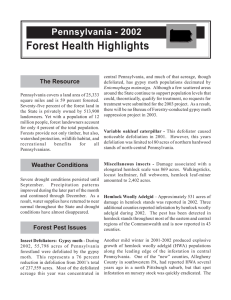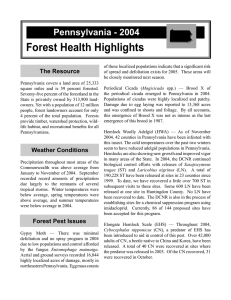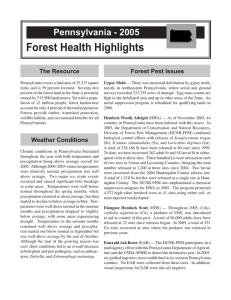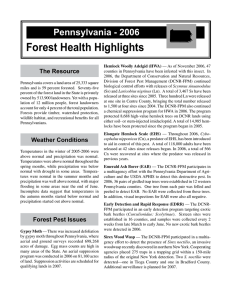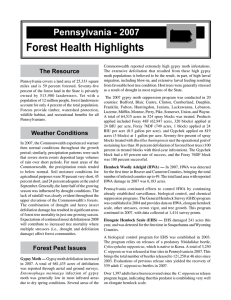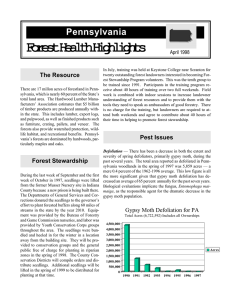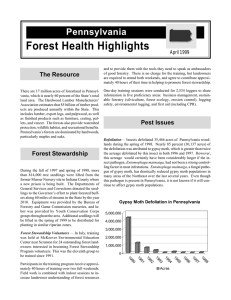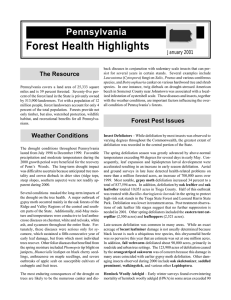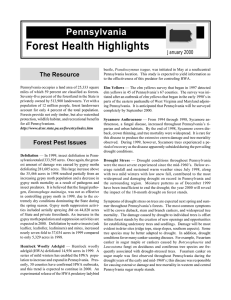Forest Health High lights Pennsylvania - 2003 The Resource
advertisement
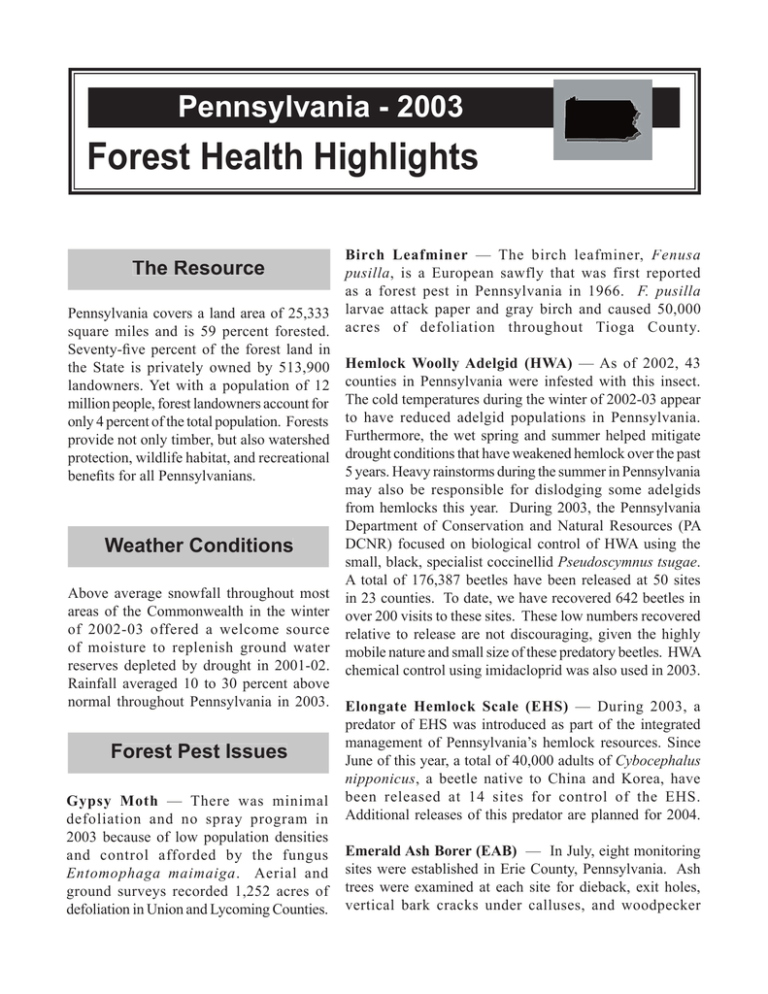
Pennsylvania - 2003 Forest Health Highlights The Resource Pennsylvania covers a land area of 25,333 square miles and is 59 percent forested. Seventy-five percent of the forest land in the State is privately owned by 513,900 landowners. Yet with a population of 12 million people, forest landowners account for only 4 percent of the total population. Forests provide not only timber, but also watershed protection, wildlife habitat, and recreational benefits for all Pennsylvanians. Weather Conditions Above average snowfall throughout most areas of the Commonwealth in the winter of 2002-03 offered a welcome source of moisture to replenish ground water reserves depleted by drought in 2001-02. Rainfall averaged 10 to 30 percent above normal throughout Pennsylvania in 2003. Forest Pest Issues Gypsy Moth — There was minimal defoliation and no spray program in 2003 because of low population densities and control afforded by the fungus Entomophaga maimaiga. Aerial and ground surveys recorded 1,252 acres of defoliation in Union and Lycoming Counties. Birch Leafminer — The birch leafminer, Fenusa pusilla, is a European sawfly that was first reported as a forest pest in Pennsylvania in 1966. F. pusilla larvae attack paper and gray birch and caused 50,000 acres of defoliation throughout Tioga County. Hemlock Woolly Adelgid (HWA) — As of 2002, 43 counties in Pennsylvania were infested with this insect. The cold temperatures during the winter of 2002-03 appear to have reduced adelgid populations in Pennsylvania. Furthermore, the wet spring and summer helped mitigate drought conditions that have weakened hemlock over the past 5 years. Heavy rainstorms during the summer in Pennsylvania may also be responsible for dislodging some adelgids from hemlocks this year. During 2003, the Pennsylvania Department of Conservation and Natural Resources (PA DCNR) focused on biological control of HWA using the small, black, specialist coccinellid Pseudoscymnus tsugae. A total of 176,387 beetles have been released at 50 sites in 23 counties. To date, we have recovered 642 beetles in over 200 visits to these sites. These low numbers recovered relative to release are not discouraging, given the highly mobile nature and small size of these predatory beetles. HWA chemical control using imidacloprid was also used in 2003. Elongate Hemlock Scale (EHS) — During 2003, a predator of EHS was introduced as part of the integrated management of Pennsylvania’s hemlock resources. Since June of this year, a total of 40,000 adults of Cybocephalus nipponicus, a beetle native to China and Korea, have been released at 14 sites for control of the EHS. Additional releases of this predator are planned for 2004. Emerald Ash Borer (EAB) — In July, eight monitoring sites were established in Erie County, Pennsylvania. Ash trees were examined at each site for dieback, exit holes, vertical bark cracks under calluses, and woodpecker damage. Lindgren funnel traps baited with 70 percent ethanol and ash foliage were used at six sites. Trap contents were collected weekly from mid-July through mid-August. No emerald ash borers were detected. Miscellaneous Insects — Several forest pests were responsible for an additional 388 plus acres of damage to the forest resource. These insects include: fall cankerworm, orange-striped oakworm, larch casebearer, and pitted ambrosia beetle, as well as several tortricid and geometrid moths. Disease Conditions Anthracnose — This type of leaf disease, caused by several fungal pathogens on a variety of host trees, was widespread throughout much of the Commonwealth during the 2003 growing season. Approximately 58,710 acres of maple, oak, sycamore, and sugar maple were severely defoliated. Tubakia leaf spot on white oak was heavy to severe in many locations, and Botryosphaeria canker was found in approximately 5,000 acres of trees that exhibited various symptoms of foliar discoloration, twig dieback, and defoliation. Fabrella Needle Blight of Hemlock — In December 2002, a stand of native hemlocks was observed to have an unusual needle cast symptom in both overstory and understory trees. Further examination of the affected needles revealed signs of a plant pathogen; the causal agent was later confirmed to be the fungal pathogen Fabrella tsugae. Fabrella needle blight on hemlock was first reported in Cumberland and Dauphin Counties in 1977. Further examination of hemlock stands revealed the presence of this disease in 16 counties in 2003. Elm Yellows — During 2003, an additional 1,098 acres were affected by the pathogen causing elm yellows. Most of this damage was found in Susquehanna County, located in the northeastern portion of the State. Delineation surveys for elm yellows were suspended in 2001 when the pathogen was determined to be widespread throughout the Commonwealth. Cooperative Studies — The Division of Forest Pest Management staff cooperatively conducted several studies that helped to protect the Commonwealth’s forest resource in 2003. These included studies of beech bark disease with researchers in Ohio; sugar maple decline with researchers from New York, Vermont, and New Hampshire; and Sudden Oak Death with the USDA Forest Service, the Animal and Plant Health Inspection Service, and the Pennsylvania Department of Agriculture. For More Information Pennsylvania Department of Conservation and Natural Resources Bureau of Forestry P.O. Box 8552 Harrisburg, PA 17105-8552 Phone: (717) 787-2703 http://www.dcnr.state.pa.us/forestry/index.htm USDA Forest Service Northeastern Area State and Private Forestry Forest Health Protection 180 Canfield Street Morgantown, WV 26505 Phone: (304) 285-1541 http://www.fs.fed.us/na/morgantown/fhp
